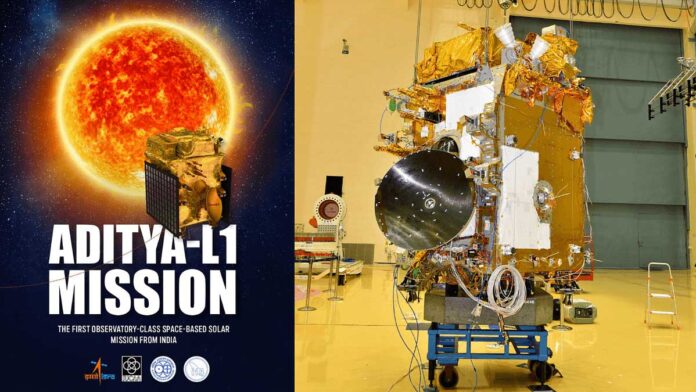After the historic achievement of being the first country to achieve a soft landing on the moon’s south polar region by Chandrayaan 3, ISRO launched its first-ever solar journey- Aditya L1 mission.
Launched last year on September 2, 2023; Aditya L1 was successfully placed in the Halo orbit situated approximately 1.5 million km away from Earth, on the dynamically shifting Sun.
Aditya L1 is a special satellite designed to thoroughly examine the Sun. It carries seven unique instruments, all created within the country—five by ISRO and two in partnership with Indian academic institutions.
The idea for this mission was born on January 2008 through the efforts of the Advisory Committee for Space Sciences (ADCOS). Originally, it was envisioned as a compact 400 kg satellite orbiting in Low Earth Orbit (800 km) equipped with a coronagraph to investigate the solar corona.
As an experiment, the budget for the mission assigned was Rs. 3 crores in the financial year 2016-2017. The mission’s scope has evolved, transforming into a comprehensive solar and space environment observatory now positioned at Lagrange point 1 (L1). Aditya L1 mission overview Launched on September 2, 2023, Aditya-L1 underwent five manoeuvres during its 16-day Earth-bound orbits to attain the necessary velocity.
Following this, a Trans-Lagrangian insertion manoeuvre kicks off its 110-day journey to the L1 Lagrange point. Upon reaching L1, a manoeuvre establishes Aditya-L1 in orbit, maintaining a gravitational balance between the Earth and the Sun. The satellite’s mission life is spent in irregular orbits around L1, positioned roughly perpendicular to the Earth-Sun line.
Objectives of Aditya L1 mission Aditya-L1 aims to explore the dynamics of the solar upper atmosphere, focusing on the chromosphere and corona. The mission intends to investigate the heating processes in these regions, delve into the physics of partially ionised plasma, and explore the triggers for coronal mass ejections (CMEs) and solar flares. One key aspect involves the in-situ observation of particles and plasma surrounding the Sun, providing valuable data for understanding the dynamic behaviour of particles originating from the Sun. The mission also seeks to unravel the mysteries surrounding the physics of the solar corona and its heating mechanisms.
Let us take a look at Aditya L1 mission’s extensive timeline:-
September 02, 2023 The launch was carried out by PSLV-C57, and was executed with remarkable success from Satish Dhawan Space Centre in Sriharikota, Andhra Pradesh, setting the stage for Aditya-L1 to commence its groundbreaking exploration of the solar environment.
September 03, 2023 The satellite was in good health and operating nominally, while the next manoeuvre was scheduled for September 05, 2023 at approximately 03:00 Hrs. IST. The initial Earth-bound manoeuvre (EBN#1) was successfully executed from ISTRAC, Bengaluru, resulting in a new orbit of 245 km x 22459 km. The other 3 Earth-bound manoeuvre were as follows:-
September 05, 2023: The second Earth-bound manoeuvre (EBN#2) was executed successfully, achieving a new orbit of 282 km x 40225 km.
September 10, 2023: The third Earth-bound manoeuvre (EBN#3) was executed successfully, achieving a new orbit of 296 km x 71767 km.
September 15, 2023: The fourth Earth-bound manoeuvre (EBN#4) was executed successfully, achieving a new orbit of 256 km x 121973 km.
September 18, 2023 The spacecraft for India’s Aditya-L1 mission initiated the collection of scientific data, contributing valuable information for scientists to analyse particles in the vicinity of Earth.
September 25, 2023 An evaluation of the space conditions surrounding the Sun-Earth Lagrange Point L1 was performed.
September 30, 2023 The spacecraft successfully escaped the sphere of Earth’s influence and journeyed towards the Sun-Earth Lagrange Point 1 (L1).
October 8, 2023 A Trajectory orrection Maneuver (TCM), initially planned, was executed on October 6, 2023, lasting approximately 16 seconds. This correction became necessary to address deviations in the trajectory identified after tracking the Trans-Lagrangian Point 1 Insertion (TL1I) manoeuvre conducted on September 19, 2023. The TCM was crucial in ensuring the spacecraft remained on its intended course for the subsequent Halo orbit insertion around L1.
November 7, 2023 HEL1OS successfully captured its inaugural High-Energy X-ray view of Solar Flares. The data obtained by HEL1OS provided researchers with valuable insights into the explosive energy release and electron acceleration that occurred during the impulsive phases of solar flares.
December 1, 2023 The Aditya Solar Wind Particle Experiment (ASPEX) payload, situated on India’s Aditya-L1 satellite, initiated its operations and functioned without any issues. SWIS, equipped with two sensor units boasting an impressive 360° field of view each, operated in planes perpendicular to one another.
December 8, 2023 The Solar Ultraviolet Imaging Telescope (SUIT) instrument aboard the Aditya-L1 spacecraft successfully captured the initial full-disk images of the Sun within the 200-400 nm wavelength range. To assess its in-orbit health, the payload was activated for the first time during the cruise phase on November 8, 2023, at 10 hours, with the high voltage (5 kV) disabled. The activation was tested using both the main and redundant DC-DC converters. Throughout the cruise phase, the electronics of the PAPA payload remained continuously activated, and the payload operation centre at Space Physics Laboratory, VSSC, analysed the 127 received data sets.
January 6, 2024 The Halo-Orbit Insertion (HOI) of the solar observatory spacecraft, Aditya-L1, was successfully completed at approximately 16:00 Hrs on January 6, 2024 (IST). The conclusive step of the manoeuvre included a brief activation of the control engines. ISRO made a statement saying, “Halo-Orbit Insertion (HOI) of its solar observatory spacecraft, Aditya-L1 was accomplished at around 4 pm on January 6, 2024.
The final phase of the manoeuvre involved the firing of control engines for a short duration. The success of this insertion not only signifies ISRO’s capabilities in such complex orbital manoeuvres, but it gives confidence to handle future interplanetary missions.” So now, the satellite in the Halo orbit around L1 has the major advantage of viewing the sun without any hindrances, eclipses or occultations.
Thus, the study about the sun will be performed without any interruptions or barriers.
With inputs from ISRO










